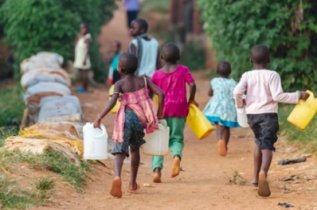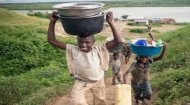Uganda Water
Today the water sector is a priority in Uganda as emphasised in the country's Poverty Eradication Action Plan. Ironically Uganda has significant water resources through its abundance of lakes however the rapid expansion of urban areas together with poor water management has left the country with a low safe water coverage. Only 32% of Ugandans have access to a basic water supply, while just 19% have access to basic sanitation with seven million Ugandans practicing open defecation. This in a country where infant mortality stands at 33.4 in 1,000 and diarrhea causes 10% of infant deaths in Uganda (2021). Inevitably this lack of clean water and sanitation has an effect on children's education in Uganda as well as the overall productivity of the nation. Teenage girls in particular often have to stay off school where there is no running water and in general being unable to wash hands is a contributory factor in the spread of illnesses such as diarrhoea. The lack of clean water also affects the environment with water collected from unsanitary boreholes, often infested with parasites and animal faceas having to be boiled before use and the fires are made from felled trees.
 One school child in Uganda explains; "Whenever I take that dirty water because we don't have a borehole the stomach start paining me and I start diarrhoea. When ever I start diarrhoea I just go back home. I can remain at home. I cannot come to school. And I get treatment. If I get treatment then I come to school. Normally my subject I like science because I want to become a nurse. I want to become a nurse to save people's lives, now if I miss science I cannot perform well. Makes me to fail the exams. Because the teacher will teach when I'm not there. If exams come, I don't know their meaning. Then I fail." One school child in Uganda explains; "Whenever I take that dirty water because we don't have a borehole the stomach start paining me and I start diarrhoea. When ever I start diarrhoea I just go back home. I can remain at home. I cannot come to school. And I get treatment. If I get treatment then I come to school. Normally my subject I like science because I want to become a nurse. I want to become a nurse to save people's lives, now if I miss science I cannot perform well. Makes me to fail the exams. Because the teacher will teach when I'm not there. If exams come, I don't know their meaning. Then I fail."
Whilst Uganda's efforts to improve its water supply are well intentioned, it still spends around 3.0% of its national budget on the water and environment sector (down from 5.0% in 2018/19) just over the 2.5971% (2020) it spends on military expenditure. The Water and Environment Sector of Uganda has recently developed a Strategic Sector Investment Plan (SSIP) to guide annual investments in the sector up until 2030. In the meantime for many, particularly in rural areas, it's a daily 1-2 km walk to fetch water from boreholes and when those boreholes dry up during the dry season or hand pumps break down, they have to reply on swamp water to meet their daily needs. Part of the problem is simply a lack of funds in what is one of the world's poorest countries and a weak coordination and management of the issue at both a national and local level.
| 
 One school child in Uganda explains; "Whenever I take that dirty water because we don't have a borehole the stomach start paining me and I start diarrhoea. When ever I start diarrhoea I just go back home. I can remain at home. I cannot come to school. And I get treatment. If I get treatment then I come to school. Normally my subject I like science because I want to become a nurse. I want to become a nurse to save people's lives, now if I miss science I cannot perform well. Makes me to fail the exams. Because the teacher will teach when I'm not there. If exams come, I don't know their meaning. Then I fail."
One school child in Uganda explains; "Whenever I take that dirty water because we don't have a borehole the stomach start paining me and I start diarrhoea. When ever I start diarrhoea I just go back home. I can remain at home. I cannot come to school. And I get treatment. If I get treatment then I come to school. Normally my subject I like science because I want to become a nurse. I want to become a nurse to save people's lives, now if I miss science I cannot perform well. Makes me to fail the exams. Because the teacher will teach when I'm not there. If exams come, I don't know their meaning. Then I fail."







